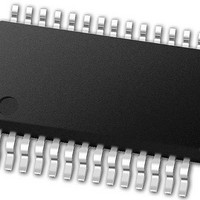PIC24FJ64GB002-I/SS Microchip Technology, PIC24FJ64GB002-I/SS Datasheet - Page 254

PIC24FJ64GB002-I/SS
Manufacturer Part Number
PIC24FJ64GB002-I/SS
Description
16-bit, 16 MIPS, 64KB Flash, 8KB RAM, Nanowatt XLP, USB OTG 28 SSOP .209in TUBE
Manufacturer
Microchip Technology
Specifications of PIC24FJ64GB002-I/SS
Processor Series
PIC24
Core
PIC24F
Data Bus Width
16 bit
Program Memory Type
Flash
Program Memory Size
64 KB
Data Ram Size
8192 B
Interface Type
I2C, SPI, UART
Maximum Clock Frequency
32 MHz
Number Of Programmable I/os
21
Number Of Timers
5
Operating Supply Voltage
2 V to 3.6 V
Maximum Operating Temperature
+ 85 C
Mounting Style
SMD/SMT
Package / Case
SSOP-28
Development Tools By Supplier
MPLAB Integrated Development Environment
Minimum Operating Temperature
- 40 C
Operating Temperature Range
- 40 C to + 85 C
Supply Current (max)
300 mA
Lead Free Status / Rohs Status
Lead free / RoHS Compliant
Available stocks
Company
Part Number
Manufacturer
Quantity
Price
Part Number:
PIC24FJ64GB002-I/SS
Manufacturer:
MICROCHIP/微芯
Quantity:
20 000
- Current page: 254 of 352
- Download datasheet (3Mb)
Note that the appropriate positions are set to ‘1’ to
indicate that they are used in the equation (for example,
nomial of length N, it is assumed that the Nth bit will
PIC24FJ64GB004 FAMILY
21.1
21.1.1
The CRC module can be programmed for CRC
polynomials of up to the 32nd order, using up to 32 bits.
Polynomial length, which reflects the highest exponent
in the equation, is selected by the PLEN<4:0> bits
(CRCCON2<4:0>).
The CRCXORL and CRCXORH registers control which
exponent terms are included in the equation. Setting a
particular bit includes that exponent term in the
equation; functionally, this includes an XOR operation
on the corresponding bit in the CRC engine. Clearing
the bit disables the XOR.
For example, consider two CRC polynomials, one a
16-bit equation and the other a 32-bit equation:
To program these polynomials into the CRC generator,
set the register bits as shown in Table 21-1.
X26 and X23). The 0 bit required by the equation is
always XORed; thus, X0 is a don’t care. For a poly-
always be used, regardless of the bit setting. Therefore,
for a polynomial length of 32, there is no 32nd bit in the
CRCxOR register.
21.1.2
The module incorporates a FIFO that works with a vari-
able data width. Input data width can be configured to
any value between one and 32 bits using the
DWIDTH<4:0> bits (CRCCON2<12:8>). When the
data width is greater than 15, the FIFO is four words
deep. When the DWIDTH value is between 15 and 8,
the FIFO is 8 words deep. When the DWIDTH value is
less than 8, the FIFO is 16 words deep.
TABLE 21-1:
DS39940D-page 254
x32 + x26 + x23 + x22 + x16 + x12 + x11 + x10 + x8 + x7
PLEN<4:0>
X<31:16>
X<15:0>
CRC Control
Bits
User Interface
POLYNOMIAL INTERFACE
DATA INTERFACE
+ x5 + x4 + x2 + x + 1
x16 + x12 + x5 + 1
CRC SETUP EXAMPLES FOR 16 AND 32-BIT POLYNOMIAL
and
0000 0000 0000 000x
0001 0000 0010 000x
16-Bit Polynomial
01111
Bit Values
The data for which the CRC is to be calculated must
first be written into the FIFO. Even if the data width is
less than 8, the smallest data element that can be writ-
ten into the FIFO is one byte. For example, if the
DWIDTH value is five, then the size of the data is
DWIDTH + 1, or six. The data is written as a whole
byte; the two unused upper bits are ignored by the
module.
Once data is written into the MSb of the CRCDAT
registers (that is, MSb as defined by the data width),
the value of the VWORD<4:0> bits (CRCCON1<12:8>)
increments by one. For example, if the DWIDTH value
is 24, the VWORD bits will increment when bit 7 of
CRCDATH is written. Therefore, CRCDATL must
always be written before CRCDATH.
The CRC engine starts shifting data when the CRCGO
bit is set and the value of VWORD is greater than zero.
Each word is copied out of the FIFO into a buffer regis-
ter, which decrements VWORD. The data is then
shifted out of the buffer. The CRC engine continues
shifting at a rate of two bits per instruction cycle, until
the VWORD value reaches zero. This means that for a
given data width, it takes half that number of instruc-
tions for each word to complete the calculation. For
example, it takes 16 cycles to calculate the CRC for a
single word of 32-bit data.
When the VWORD value reaches the maximum value
for the configured value of DWIDTH (4, 8 or 16), the
CRCFUL bit becomes set. When the VWORD value
reaches zero, the CRCMPT bit becomes set. The FIFO
is emptied and VWORD<4:0> are set to ‘00000’
whenever CRCEN is ‘0’.
At least one instruction cycle must pass, after a write to
CRCDAT, before a read of the VWORD bits is done.
0000 0100 1100 0001
0001 1101 1011 011x
32-Bit Polynomial
2010 Microchip Technology Inc.
11111
Related parts for PIC24FJ64GB002-I/SS
Image
Part Number
Description
Manufacturer
Datasheet
Request
R

Part Number:
Description:
Manufacturer:
Microchip Technology Inc.
Datasheet:

Part Number:
Description:
Manufacturer:
Microchip Technology Inc.
Datasheet:

Part Number:
Description:
Manufacturer:
Microchip Technology Inc.
Datasheet:

Part Number:
Description:
Manufacturer:
Microchip Technology Inc.
Datasheet:

Part Number:
Description:
Manufacturer:
Microchip Technology Inc.
Datasheet:

Part Number:
Description:
Manufacturer:
Microchip Technology Inc.
Datasheet:

Part Number:
Description:
Manufacturer:
Microchip Technology Inc.
Datasheet:

Part Number:
Description:
Manufacturer:
Microchip Technology Inc.
Datasheet:











